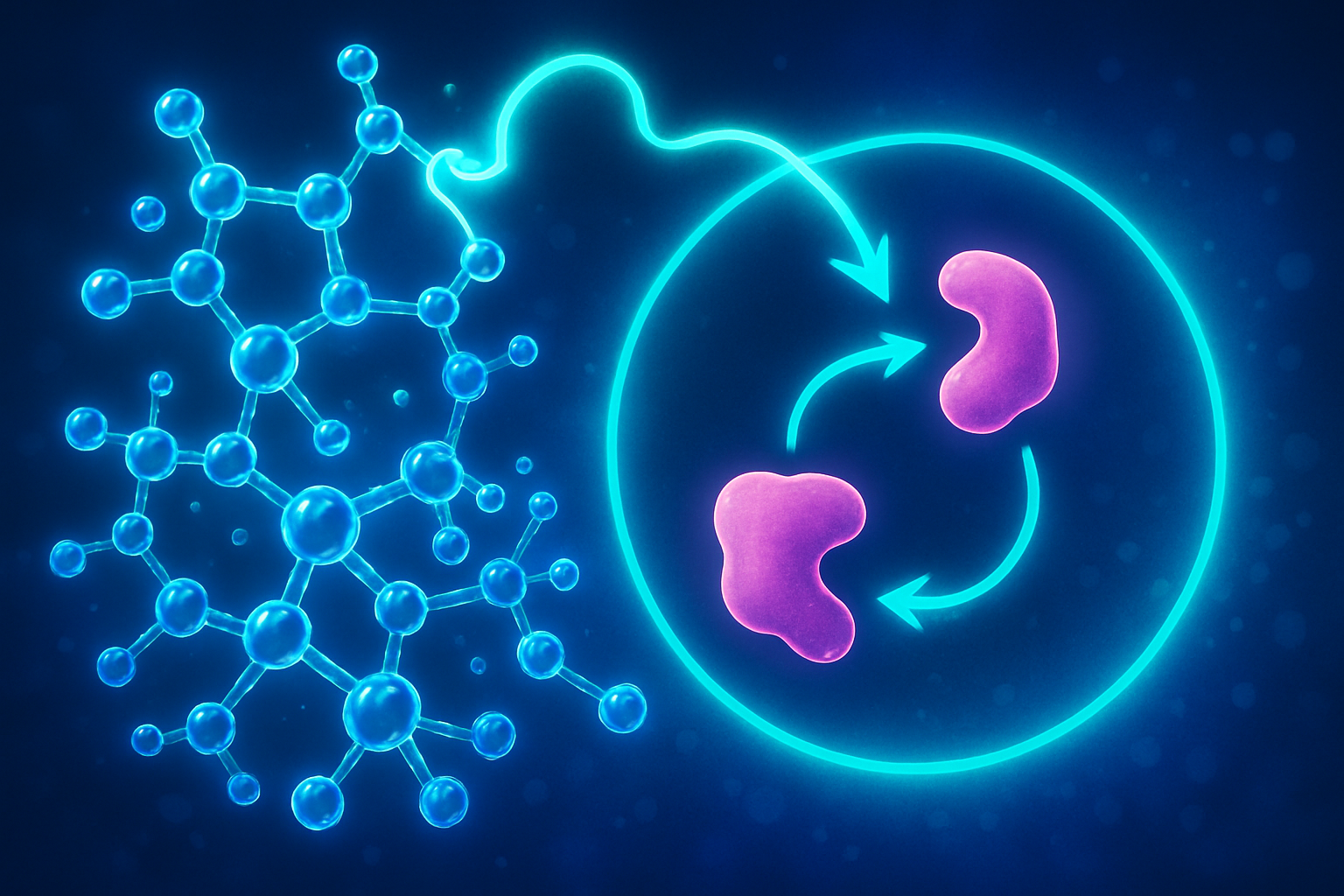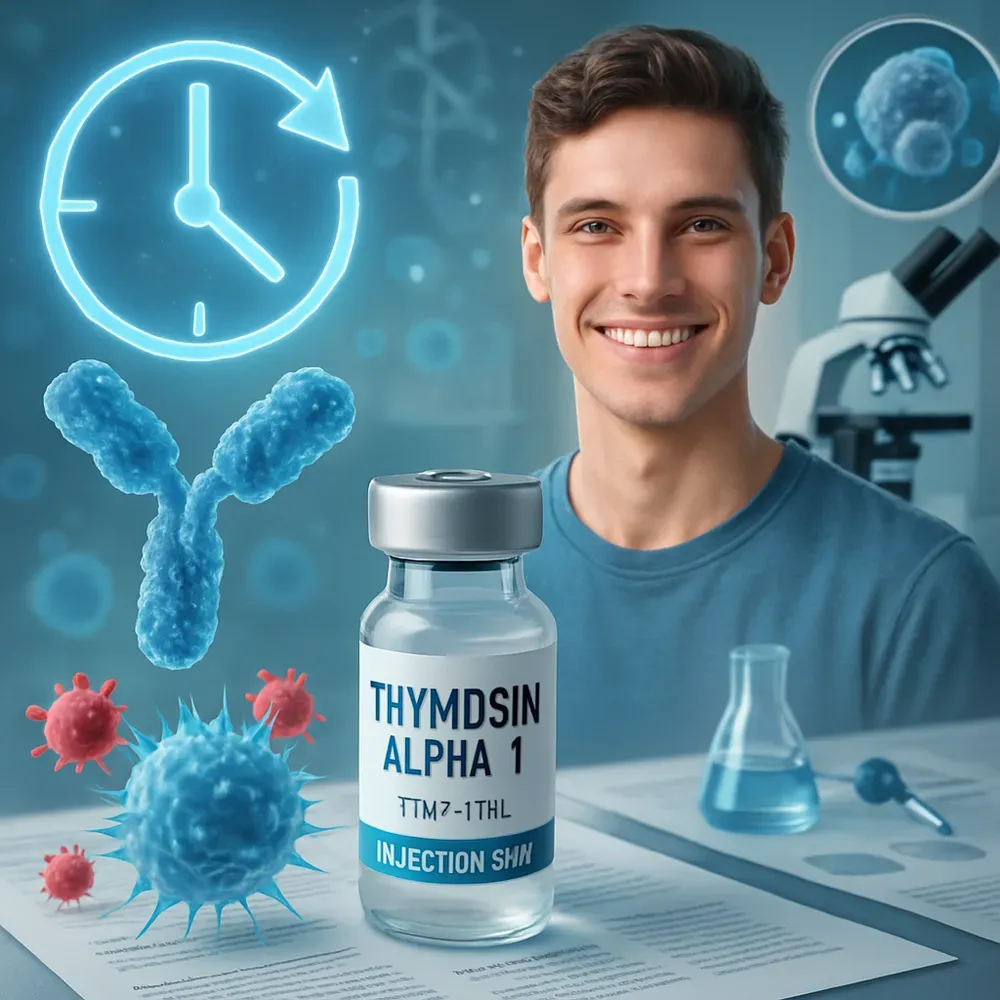What is TB-500? A Deep Dive into the Healing Peptide
From tissue repair to injury recovery, TB-500 has captured the attention of athletes and biohackers alike. Discover how this healing peptide actually works.

TB-500 has become one of the most talked-about peptides in recovery and healing circles. Athletes mention it in forums. Biohackers experiment with it. Researchers study its potential. But what exactly is this compound, and why has it gained so much attention?
TB-500 is a synthetic version of Thymosin Beta-4, a naturally occurring peptide found in nearly all human cells. Your body already produces Thymosin Beta-4 to promote healing and tissue repair. TB-500 replicates the most active region of this molecule, making it more stable and practical for therapeutic use.
The peptide works at a cellular level to encourage healing, reduce inflammation, and support tissue regeneration. Unlike traditional recovery methods that simply mask pain or reduce swelling, TB-500 appears to address the underlying healing process itself.
This guide explores everything you need to know about TB-500—its origins, mechanisms of action, potential applications, and what current research tells us about this intriguing healing peptide.
The Science Behind TB-500 and Thymosin Beta-4
Thymosin Beta-4 exists in high concentrations wherever healing occurs in your body. When you cut your skin, strain a muscle, or experience any tissue damage, your cells release this peptide as part of the natural repair response.
TB-500 consists of a synthetic 43-amino-acid sequence that mirrors the active region of Thymosin Beta-4. Scientists created this shorter sequence because it's easier to manufacture and remains stable during storage and administration. The full Thymosin Beta-4 molecule contains additional amino acids that aren't necessary for its healing effects.
The peptide's primary mechanism involves actin regulation. Actin is a protein that forms the structural framework inside cells. By binding to actin, TB-500 influences cell migration, which is essential for healing. Cells need to move to injury sites to repair damage, and TB-500 facilitates this movement.
Research published in the Journal of Cell Science demonstrates that Thymosin Beta-4 promotes cell migration and tissue repair through actin sequestration. This mechanism distinguishes TB-500 from growth factors or anti-inflammatory compounds that work through different pathways.
Beyond cell migration, TB-500 appears to influence angiogenesis—the formation of new blood vessels. Better blood flow to injured areas means more oxygen and nutrients reach damaged tissue, potentially accelerating recovery.
How TB-500 Differs from Other Healing Peptides
TB-500 often gets compared to BPC-157, another popular healing peptide. While both promote recovery, they work through different mechanisms. BPC-157 focuses heavily on gut healing and works partially through growth hormone pathways. TB-500 operates primarily through actin regulation and affects a broader range of tissues.
Unlike growth hormone secretagogues such as Ipamorelin or CJC-1295, TB-500 doesn't stimulate growth hormone production. It works independently of the growth hormone axis, making it useful for people who can't or don't want to influence their GH levels.
TB-500 also differs significantly from traditional anti-inflammatory medications. NSAIDs like ibuprofen reduce inflammation by blocking prostaglandin production, but they may actually slow healing in some contexts. TB-500 appears to modulate inflammation while supporting the healing process rather than simply suppressing inflammatory signals.
Corticosteroids represent another common approach to injury management. While effective for inflammation, steroids can impair tissue healing and weaken connective tissue over time. TB-500 takes the opposite approach, potentially strengthening tissues as they repair.
The peptide's mechanism through actin makes it unique in peptide therapy. Few other compounds directly influence the cellular scaffolding that determines how cells move and organize during healing.
Potential Applications of TB-500 in Clinical Research
Animal studies form the bulk of TB-500 and Thymosin Beta-4 research. These studies have explored various injury types and healing scenarios, providing insight into the peptide's potential applications.
Cardiovascular research has shown particular interest in Thymosin Beta-4. Studies in animal models suggest it may support heart tissue recovery after cardiac events. Research published in Circulation Research found that Thymosin Beta-4 administration improved cardiac function following myocardial infarction in mice by promoting blood vessel formation and reducing scarring.
Wound healing represents another major area of investigation. Multiple studies have examined how TB-500 affects skin healing, with some research suggesting faster wound closure and improved tissue quality. The peptide may help in both acute injuries and chronic wounds that resist traditional treatment.
Tendon and ligament injuries pose particular challenges because these tissues heal slowly due to limited blood supply. Animal research indicates TB-500 might accelerate healing in these difficult areas, though human data remains limited.
Eye injury research has produced intriguing findings. Studies suggest Thymosin Beta-4 may help repair corneal damage and other ocular injuries. Some research has progressed to human trials in ophthalmology applications.
Neurological applications represent an emerging frontier. Preliminary research explores whether TB-500 might support recovery from traumatic brain injury or stroke by promoting neural tissue repair and reducing inflammation.
Understanding TB-500 in Athletic and Recovery Contexts
Athletes have shown significant interest in TB-500 for recovery purposes. The peptide's reputation in athletic circles stems from reports of faster healing from training-related injuries and reduced recovery time between intense sessions.
Muscle strains and tears are common in sports. Traditional recovery involves rest, ice, and gradual return to activity. Some athletes report that TB-500 supplementation during recovery periods correlates with faster return to training, though controlled human studies are lacking.
Joint issues plague many athletes, especially in high-impact sports. TB-500's potential effects on connective tissue healing make it attractive for those dealing with tendon or ligament problems. However, the peptide isn't approved for athletic recovery, and sports organizations have taken positions on its use.
The World Anti-Doping Agency (WADA) prohibits TB-500 and Thymosin Beta-4 for competitive athletes. They're listed on the prohibited substances list under peptide hormones and growth factors. Athletes subject to drug testing should avoid TB-500 entirely.
Recovery isn't limited to injury healing. Some people use TB-500 as part of general wellness protocols, hoping to maintain tissue health and support the body's natural repair processes. The logic is that supporting healing mechanisms might prevent injuries before they occur.
Flexibility and range of motion sometimes improve during TB-500 protocols, according to anecdotal reports. If the peptide does support connective tissue health, improved mobility could be a secondary benefit alongside faster recovery from specific injuries.
TB-500 Administration and Practical Considerations
TB-500 arrives as lyophilized powder that requires reconstitution with bacteriostatic water before use. The typical vial contains 2mg or 5mg of peptide. Once reconstituted, the solution must be refrigerated and used within 2-4 weeks.
Subcutaneous injection is the standard administration method. Common injection sites include the abdomen, thigh, or upper arm—areas with adequate subcutaneous tissue. Some protocols suggest injecting near the injury site, while others indicate systemic circulation distributes the peptide effectively regardless of injection location.
Dosing protocols vary widely in anecdotal reports and research contexts. Animal studies have used doses ranging from micrograms to milligrams per kilogram of body weight. Human equivalent doses are difficult to extrapolate directly from animal research.
Common self-directed protocols mentioned in peptide communities typically involve doses of 2-2.5mg administered 2-3 times weekly. Some protocols use higher initial "loading" phases followed by lower maintenance doses. However, no standardized human dosing guidelines exist from regulatory authorities.
Timing considerations include whether to take TB-500 with or without food, though as a subcutaneous injection, dietary factors likely have minimal impact on absorption. Some users prefer dosing in the evening, others don't find timing particularly relevant.
Peptide therapy requires proper supplies: bacteriostatic water for reconstitution, insulin syringes for injection, alcohol wipes for sterilization, and appropriate refrigeration for storage. A peptide calculator helps determine exact dosing after reconstitution.
What Current Research Says About TB-500
Clinical research on TB-500 specifically remains limited compared to studies on the natural peptide Thymosin Beta-4. Most published research examines Thymosin Beta-4 in various animal models and some human applications.
Wound healing studies consistently show positive effects in animal models. A study in the American Journal of Pathology demonstrated that Thymosin Beta-4 enhanced wound healing in diabetic mice, a population that typically experiences impaired healing. The peptide improved wound closure rates and tissue quality.
Cardiac research has produced some of the most compelling findings. Multiple studies in cardiac injury models show that Thymosin Beta-4 administration correlates with improved outcomes. The peptide appears to support new blood vessel formation, reduce excessive scarring, and help preserve heart function after damage.
Ophthalmology represents one area where Thymosin Beta-4 research has progressed to human trials. Studies have examined its use for dry eye disease and corneal injuries, with some positive outcomes reported. This represents one of the few areas with direct human data rather than purely animal research.
Neurological research remains mostly in early stages. Animal studies suggest potential benefits for traumatic brain injury and stroke recovery, but human applications remain theoretical. The peptide's anti-inflammatory effects and support for tissue repair could theoretically benefit neural tissue.
Hair growth research has explored whether Thymosin Beta-4 affects hair follicle health. Some studies suggest the peptide might support hair growth through effects on follicle stem cells, though this application remains speculative for human use.
Limitations of current research include small sample sizes in human studies, reliance on animal models for many applications, lack of large-scale controlled trials, and limited long-term safety data. Most clinical knowledge comes from veterinary use or extrapolation from animal research.
Safety Considerations and Potential Side Effects
TB-500 and Thymosin Beta-4 appear relatively well-tolerated based on available research and anecdotal reports. Serious adverse events are rarely reported in animal studies at therapeutic doses.
Common mild effects reported anecdotally include temporary lethargy or tiredness, particularly in the first few days of use. Some users report feeling unusually tired for several hours after injection. Headaches occur occasionally, though it's unclear if they're directly related to TB-500 or coincidental.
Injection site reactions are possible with any injectable compound. Redness, mild swelling, or tenderness at injection sites can occur. Proper injection technique and site rotation minimize these issues.
Theoretical concerns exist around TB-500's effects on cell migration and proliferation. Because the peptide promotes cell movement and angiogenesis, questions arise about whether it could theoretically affect cancer cells. No evidence suggests TB-500 causes cancer, but its effects on cell behavior warrant consideration for anyone with a history of malignancy.
The peptide's cardiovascular effects, while potentially beneficial for healing, mean people with certain heart conditions should approach use cautiously. Anyone with significant cardiac disease should consult appropriate medical professionals before considering peptide therapy.
TB-500 isn't approved by the FDA for human use. It exists in a regulatory gray area—not explicitly illegal for personal use in many jurisdictions, but not approved as a medication. This means quality control, purity, and actual content can vary significantly between suppliers.
Long-term safety data doesn't exist for human TB-500 use. Most research involves relatively short-term administration. Effects of continuous long-term use remain unknown.
TB-500 Quality and Sourcing Considerations
The peptide market includes suppliers of varying quality and reliability. TB-500 purity can range from highly pure pharmaceutical-grade to contaminated or mislabeled products. Without independent testing, users can't verify what's actually in their vials.
Third-party testing through laboratories that perform certificate of analysis testing can verify peptide purity and identity. Some suppliers provide these certificates, while others don't. COA testing typically uses methods like HPLC (high-performance liquid chromatography) and mass spectrometry.
Proper storage matters for maintaining peptide integrity. Lyophilized TB-500 should be stored in a freezer before reconstitution. After mixing with bacteriostatic water, refrigeration is essential. Exposure to heat, light, or frequent temperature fluctuations degrades peptides.
Counterfeit peptides represent a real concern in this market. Some products labeled as TB-500 may contain little or no active peptide. Others might be contaminated with bacteria, endotoxins, or other compounds. This is why source selection matters tremendously.
Price often correlates with quality, though not always. Extremely cheap TB-500 should raise suspicions about purity and authenticity. However, high prices don't guarantee quality without independent verification.
International sourcing adds complexity. Many TB-500 suppliers operate internationally, shipping across borders. This raises legal questions depending on jurisdiction and increases the risk of products being seized by customs.
Comparing TB-500 to Established Medical Treatments
Standard medical care for injuries typically involves the RICE protocol: rest, ice, compression, and elevation. These approaches manage symptoms and create conditions for natural healing but don't actively accelerate the healing process at a cellular level.
Physical therapy represents the gold standard for rehabilitation from many injuries. PT works through mechanical means—strengthening surrounding tissues, improving flexibility, and gradually loading injured areas. TB-500 would theoretically complement rather than replace physical therapy.
Platelet-rich plasma (PRP) injections have gained acceptance for certain injuries. PRP concentrates growth factors from the patient's own blood and injects them at injury sites. Some research suggests benefits for tendon injuries and osteoarthritis. PRP and TB-500 work through different mechanisms—PRP delivers multiple growth factors, while TB-500 focuses on actin-mediated effects.
Stem cell therapies represent another advanced approach to healing. These treatments aim to deliver cells capable of differentiating into needed tissue types. TB-500's mechanism of supporting existing cells' healing functions differs from directly introducing new cells.
Surgical intervention becomes necessary for severe injuries like complete tendon ruptures or significant structural damage. No peptide can replace surgery when mechanical repair is needed. TB-500 might theoretically support post-surgical healing, though research on this application is limited.
The Future of TB-500 Research and Development
Thymosin Beta-4 research continues in academic and clinical settings. Some work focuses on developing pharmaceutical formulations for specific approved indications. If research demonstrates clear benefits with acceptable safety profiles, regulated TB-500 products could eventually reach the market.
Ophthalmology remains the most advanced clinical area, with ongoing trials examining Thymosin Beta-4 for various eye conditions. This pathway could provide the first FDA-approved applications of the peptide or its derivatives.
Cardiac applications hold significant potential given the need for better treatments supporting heart tissue recovery. Continued research in this area could lead to breakthrough therapies for heart attack recovery or heart failure management.
Wound healing in challenging populations—such as diabetics who experience impaired healing—represents another promising research direction. If TB-500 proves effective and safe for chronic wounds, it could address a significant unmet medical need.
Combination approaches might emerge, using TB-500 alongside other therapies. The peptide's unique mechanism could complement growth factors, physical therapy, or other interventions for synergistic effects.
Regulatory pathways for peptide therapies are evolving. As more peptides progress through clinical trials and approval processes, the framework for bringing these compounds to market becomes clearer. TB-500 could benefit from this maturing regulatory landscape.
Making Informed Decisions About TB-500
Anyone considering TB-500 should start with thorough research. Understanding the peptide's mechanisms, potential benefits, risks, and limitations helps create realistic expectations. The gap between animal research and proven human benefits is significant.
Consulting with healthcare providers experienced in peptide therapy provides valuable perspective. While many conventional doctors aren't familiar with research peptides, some physicians specialize in this area and can offer informed guidance.
Setting clear goals helps determine if TB-500 makes sense for your situation. Are you addressing a specific injury? Seeking general recovery support? Hoping for preventive benefits? Different goals might warrant different approaches.
Starting conservatively with lower doses allows you to assess tolerance and response before committing to full protocols. This approach minimizes potential risks while providing information about how your body responds.
Tracking results objectively helps distinguish actual effects from placebo responses or natural healing. Keep notes on pain levels, range of motion, functional abilities, and other measurable factors throughout your protocol.
Understanding that TB-500 isn't a magic solution keeps expectations realistic. Healing takes time regardless of intervention. The peptide might support and potentially accelerate your body's natural processes, but it doesn't instantly repair damage.
TB-500 and the Broader Peptide Therapy Landscape
TB-500 fits within a growing interest in peptide-based approaches to health and performance. Peptides like BPC-157, Ipamorelin, CJC-1295, and others each target different biological pathways and offer distinct potential benefits.
The peptide therapy movement reflects a broader shift toward understanding and working with the body's natural signaling molecules. Rather than introducing completely foreign compounds, these therapies use sequences that mimic or enhance existing biological processes.
Research peptides occupy a unique space between supplements and pharmaceutical drugs. They're more targeted and potentially powerful than typical supplements, yet lack the extensive research, regulatory approval, and safety data of approved medications.
The community aspect of peptide therapy creates both benefits and risks. Online forums and communities share experiences and protocols, providing practical information unavailable in medical literature. However, anecdotal reports can't replace controlled research, and misinformation spreads easily.
As peptide research advances, some compounds will likely transition from research chemicals to approved therapeutics. Others may prove less effective than hoped or present safety concerns that limit their use. TB-500 could follow either path depending on future research outcomes.
If you're considering TB-500 after reading this guide, remember that source quality makes all the difference. We've compiled a comprehensive
Peptide Vendor Directory featuring suppliers with certificates of analysis, transparent testing, and proven reliability. Make informed decisions with vetted sources that prioritize purity and safety.
What exactly is TB-500 and how does it differ from Thymosin Beta-4?
TB-500 is a synthetic peptide that replicates the active region of Thymosin Beta-4, a naturally occurring peptide in your body.
While Thymosin Beta-4 is the full-length molecule your cells produce for healing and repair, TB-500 consists of a 43-amino-acid sequence that contains the most therapeutically active portion. Scientists created TB-500 because this shorter sequence is easier to manufacture, more stable during storage, and simpler to work with in research and therapeutic contexts.
The synthetic version retains the healing-promoting properties of the natural peptide while being more practical for external administration.
Your body already uses Thymosin Beta-4 as part of its natural healing response to injuries, and TB-500 essentially supplements this process with additional healing signals.
How does TB-500 actually work to promote healing?
TB-500 is primarily researched and used for its potential healing and recovery properties. In animal research, it has been studied for wound healing, tendon and ligament injuries, cardiac tissue repair, corneal and eye injuries, muscle strains and tears, and inflammatory conditions. In athletic and recovery contexts, people report using it for faster recovery from training-related injuries, support for chronic tendon or ligament issues, post-surgical healing support, and general tissue maintenance. However, it's important to understand that TB-500 is not FDA-approved for human use, most evidence comes from animal studies, and anecdotal reports from users lack the rigor of controlled clinical trials. The peptide is prohibited by WADA for competitive athletes, meaning it cannot be used in contexts subject to athletic drug testing.
What does TB-500 do that other healing methods don't?
TB-500's unique mechanism through actin regulation distinguishes it from other approaches to healing and recovery. Unlike NSAIDs that reduce inflammation by blocking prostaglandins but may slow healing, TB-500 appears to modulate inflammation while supporting repair. Compared to corticosteroids that suppress inflammation but can weaken tissue, TB-500 potentially strengthens tissue during healing. Unlike growth hormone secretagogues that work through the GH pathway, TB-500 operates independently through actin. Different from PRP injections that deliver concentrated growth factors, TB-500 provides a specific peptide signal for cell migration. The peptide's ability to promote cell migration at injury sites represents a distinct approach. Rather than simply managing symptoms or providing building blocks, TB-500 appears to enhance the cellular processes your body uses for repair. However, whether it offers advantages over established medical treatments remains a question requiring more rigorous human research.
Is TB-500 the same thing as a steroid?
No, TB-500 is not a steroid. It's a peptide, which is a chain of amino acids, while steroids are lipid-based hormones with a completely different chemical structure. Steroids like testosterone or cortisol work by binding to nuclear receptors and changing gene expression. TB-500 works by binding to actin proteins and influencing cell structure and migration. The confusion might arise because both substances are sometimes discussed in athletic contexts, but their mechanisms, effects, and classifications differ entirely. TB-500 doesn't have the anabolic effects on muscle growth that anabolic steroids produce, nor does it have the anti-inflammatory mechanism of corticosteroids. While both TB-500 and anabolic steroids are prohibited by WADA for competitive athletes, they're in different categories of prohibited substances. TB-500 falls under peptide hormones and growth factors, not under anabolic agents.
What does TB-500 do for athletes specifically?
Athletes report interest in TB-500 primarily for recovery from training-related injuries and reducing downtime between intense training sessions. The peptide's potential effects on tendon, ligament, and muscle healing make it attractive for sports-related soft tissue injuries. Some athletes report faster recovery from strains, improved healing of chronic overuse injuries, reduced inflammation after intense training, and better flexibility and range of motion. However, several critical points need emphasis: TB-500 is prohibited by WADA and most sports organizations, there are no controlled studies proving benefits specifically for athletic recovery in humans, anecdotal reports cannot substitute for rigorous research, and using prohibited substances carries both health risks and competitive consequences. Any athlete subject to drug testing should completely avoid TB-500. The peptide's use in sports remains controversial and unsupported by clinical evidence specific to athletic applications.
How is TB-500 administered and what's a typical dosage?
TB-500 is administered through subcutaneous injection after reconstituting the lyophilized powder with bacteriostatic water. Common injection sites include the abdomen, thigh, or upper arm. The peptide typically comes in 2mg or 5mg vials that must be mixed with bacteriostatic water before use and then refrigerated. Regarding dosage, no official medical guidelines exist since TB-500 isn't approved for human use. Anecdotal protocols mentioned in peptide communities typically involve 2-2.5mg administered 2-3 times per week, sometimes with higher initial loading phases followed by lower maintenance doses. However, these are user-reported protocols, not medical recommendations. Dosing extrapolated from animal research doesn't translate directly to humans. Anyone considering TB-500 should understand they're working without established human dosing guidelines and should start conservatively if proceeding.
What are the side effects of TB-500?
Based on available animal research and anecdotal human reports, TB-500 appears relatively well-tolerated, though comprehensive safety data is lacking. Commonly reported minor effects include temporary lethargy or fatigue, particularly shortly after injection, occasional headaches, and mild injection site reactions like redness or tenderness. Theoretical concerns that warrant consideration include unknown effects in people with cancer history given the peptide's influence on cell migration, potential cardiovascular effects that could matter for those with heart conditions, and lack of long-term safety data for extended use. Serious adverse events are rarely reported in animal studies at therapeutic doses. However, the absence of large-scale human trials means the true safety profile remains incompletely understood. Quality and purity issues with research peptides add another risk factor, as contaminated or mislabeled products could cause effects unrelated to TB-500 itself.
Where can I learn more about TB-500 research?
The most reliable TB-500 and Thymosin Beta-4 research appears in peer-reviewed scientific journals. Key research areas include cardiovascular studies in journals like Circulation Research examining heart tissue repair, wound healing research in journals like the American Journal of Pathology, ophthalmology studies on corneal injury and dry eye, and cell biology research in journals like the Journal of Cell Science. You can search medical databases like PubMed using terms like "Thymosin Beta-4" or "TB-500" to find published research. Keep in mind that most studies involve animal models rather than human subjects. Clinical trials databases like ClinicalTrials.gov may list ongoing human research. Academic institutions and research hospitals conducting peptide research sometimes publish updates on their findings. However, be cautious of information from suppliers or sources with commercial interests, as they may overstate benefits or downplay limitations.
Is TB-500 legal and can I buy it?
TB-500 exists in a regulatory gray area. It's not FDA-approved for human use, which means it's not legal as a medication or prescription drug. However, it's available from research chemical suppliers who sell it "for research purposes only." Legality varies by jurisdiction, and importing peptides may involve customs regulations. The peptide is explicitly prohibited for competitive athletes by WADA and most sports organizations. For non-athletes, possession for personal use isn't federally prosecuted in the US, but it's not technically legal either. Purchasing TB-500 means buying a non-approved research chemical without quality guarantees or regulatory oversight. Many suppliers operate in international markets with varying legal frameworks. Anyone considering TB-500 should understand they're working with an unapproved compound in an unregulated market, accepting both legal ambiguity and quality control risks.
How long does it take to see results from TB-500?
Based on anecdotal reports, the timeline for noticing effects from TB-500 varies considerably depending on the type and severity of injury, individual response factors, dosing protocol used, and whether TB-500 is combined with other therapies. Some users report initial changes in pain or inflammation within 1-2 weeks, while significant healing improvements might take 4-8 weeks or longer for chronic or severe injuries. Tissue type matters too—muscle injuries might respond differently than tendon or ligament issues, which heal slowly regardless of intervention. It's important to maintain realistic expectations. TB-500 isn't a rapid healing solution, and natural healing takes time regardless of supplementation. Any effects should be evaluated objectively rather than through wishful thinking or placebo response. If you're not noticing any changes after 8-12 weeks of consistent use, the peptide might not be effective for your particular situation, or quality issues with your supply might be a factor.
Can TB-500 be combined with other peptides or treatments?
TB-500 is often discussed in combination with other peptides, particularly BPC-157, since they work through different mechanisms and might offer complementary benefits. TB-500 focuses on actin-mediated cell migration while BPC-157 emphasizes gut healing and works partially through growth hormone pathways. Some people combine TB-500 with growth hormone secretagogues like Ipamorelin or CJC-1295, reasoning that supporting both the GH axis and direct healing signals might be beneficial. TB-500 can theoretically be used alongside standard treatments like physical therapy, rest and recovery protocols, or anti-inflammatory medications. However, no research establishes optimal combination protocols or confirms that combining peptides produces better results than single peptides. When combining any substances, risks potentially compound. Start with one compound to assess individual response before adding others. Anyone considering combination approaches should proceed conservatively and ideally with guidance from a knowledgeable healthcare provider.
Legal Disclaimer:
These statements have not been evaluated by the FDA and are not intended to diagnose, treat, cure, or prevent any disease. This information is for educational and research purposes only.










